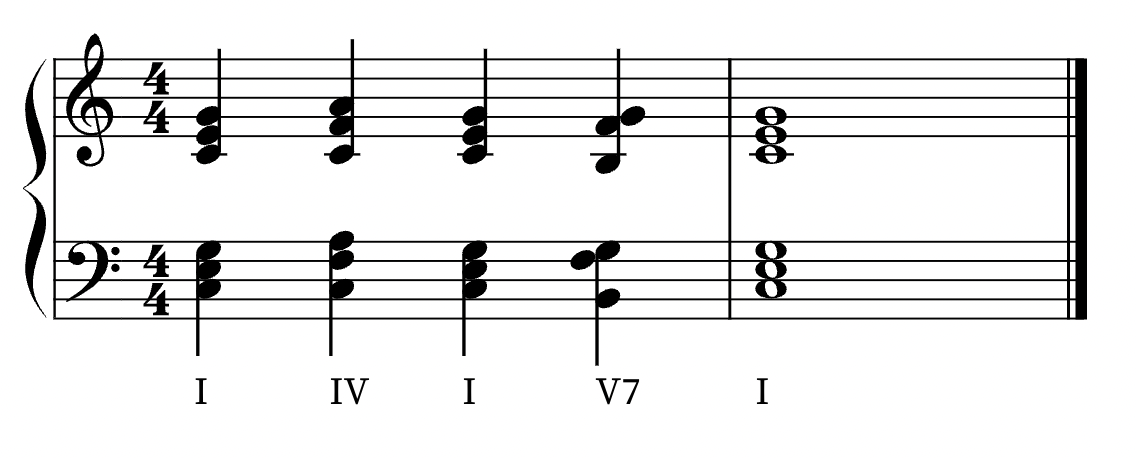This page lists some practice resources for the more common piano proficiency exam items for non-piano majors at Jacobs. To suggest a resource for this page, email secpiano@iu.edu.
Quick Links:
- Transposing an Accompaniment (item B/3)
- Sightreading Vocal/Instrumental Part with Piano Accompaniment (item C/5)
- Hymn Reading (item D)
- Four-part Open Score Reading (item F/6a/6b)
- Sightreading (item G/4)
- Improvising Accompaniment (item J)
- Chord Progressions (item M)
- Prepared Piece (item N1/N2/8)
- Traditional/Patriotic Songs (item O)
- Scales/Arpeggios/etc. (item R/11)
Transposing an Accompaniment
This is item B for undergrads; item 3 for graduate students.
Many of the songs in 24 Italian Songs and Arias are good candidates for practicing this skill.
Sightreading Vocal/Instrumental Part with Piano Accompaniment
This is item C for undergrads; item 5 for graduate students.
Students may choose to either sing the vocal/instrumental part while playing the piano part; or play both parts (all 3 staves) together simultaneously on the piano, as long as texture and harmony is preserved. (Playing just the left hand of the piano part in the left hand, and just the vocal melody in the right hand, is NOT a full enough rendition for the proficiency exam standards.)
Undergraduate students can practice with the first page of these songs:
Graduate students can practice with the first page of these songs:
- Mendelssohn Frühlingslied (PDF) (would NOT have to be Allegro assai vivace for the exam - more of a Moderato)
- Schumann Op. 48, no. 10 (PDF)
- Brahms Op. 63, no. 8 (PDF)
Hymn Reading
This is item D for undergrads: Sight read hymns and anthems in a four part texture.
Many hymns for practicing may be found at the Open Hymnal Project (http://openhymnal.org)
Four-part Open Score Reading
This is item F for undergrads; item 6a/6b for graduate students.
Keyboard Skills for Music Educators: Score Reading, Shellie Gregorich, Benjamin Moritz, Routledge,
ISBN 978-0-415-88898-1
Many open choral scores for practice can also be found here: http://www.cantatedomino.org/cd/choral-index.html (however, not all of them are SATB, and be careful not to rely on the reduction at the bottom of most pages)
(only if you need to read open score with alto clef for your exam): Preparatory Exercises in Score Reading, R.O. Morris & Howard Ferguson, Oxford University Press, ISBN 978-0193214750
Sightreading
This is item G for undergrads; item 4 for graduate students.
You can expect the proficiency exam sight-reading to be a short excerpt (approximately 12-16 measures), in a more contrapuntal/imitative texture that requires independence in both hands. (An example of something that would be too simple, and NOT up to proficiency exam standards, would be an excerpt that has a melody in the right hand with a simple blocked-chord accompaniment in the left hand.)
Exercises of a comparable difficulty may be found in:
- many of the exercises of Improve Your Sight-reading! Piano, Level 4, composed by Paul Harris, published by Faber Music Ltd.
- the harder exercises of Right@Sight Grade Three, composed by Thomas Johnson, rev. Caroline Evans, Edition Peters, EP 7541,
ISMN M-57708-362-9
You may also find this resource helpful for guiding your practice: How to Sight-Read Both Clefs at the Same Time, by Emmanuelle Fonsny
Improvising Accompaniment
This is item J for undergrads: Improvise at sight an accompaniment to a melody (melody must also be performed), with or without chord symbols. Blocked chords are not an acceptable accompaniment, and melodies may require secondary chords or secondary dominants.
To practice, try the following resources, which have many lead sheet-style folk tunes with chord symbols:
- http://www.free-notes.net (most examples that have been categorized as "Trad" or "folk song" are good candidates for practice. Many are transposable so that you can practice in different keys!)
- https://pianosongdownload.com/leadsheets.html (many of these are in C or G major, so make sure to also practice other lead sheets that are in different keys, including minor keys)
- https://michaelkravchuk.com/lead-sheets/
- Doing a Google search for "free piano lead sheets" also turns up many resources!
Chord Progressions
This is item M for undergrads: I-IV-I-V7-I in all major/minor keys, after the relevant scale, three voices in each hand.
See the image below for an example of an acceptable I-IV-I-V7-I chord progression in C major: 
Prepared Piece
This is item N1/N2 for undergrads; item 8 for graduate students.
View a list of approved repertoire here.
Many can be found online at IMSLP; all can be found in Music for Millions, Vol 17: Easy Classics to Moderns, ed. Denes Agay, Music Sales America, ISBN 978-0825640179
Music Education - Instrumental students can choose from the approved solo piano repertoire at the link above, but (as of Spring 2024) they also have the option to perform the piano accompaniment of two representative exercises from a beginning or intermediate-level method book:
- Instrumental BME Band/Jazz: Minuet No. 2 and American Patrol (memorization not required)
- Instrumental BME Strings: Ode to Joy and William Tell Overture (memorization not required)
Traditional/Patriotic Songs
This is item O for undergrads.
Where can I get a copy of Happy Birthday? (links to PDF)
Where can I get a copy of Lift Every Voice and Sing? (links to PDF)
Where can I get a copy of My Country 'Tis of Thee? (links to PDF)
Where can I get a copy of The Star-Spangled Banner in A-flat or in B-flat? (links to PDFs)
Scales/Arpeggios/Etc.
This is item R for undergrads; item 11 for graduate students.
Recommended resources:
- The Brown Scale Book, Frederick Harris Music, ISBN 0-88797-018-4
- Alfred's The Complete Book of Scales, Chords, Arpeggios & Cadences
How should arpeggios be played? (links to PDF)
How should broken chords be played? (links to PDF) These are also called "triads and inversions" in some texts.
How should blocked chords be played? (links to PDF) These are also called "triads and inversions" in some texts.

